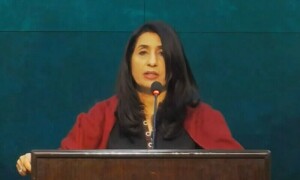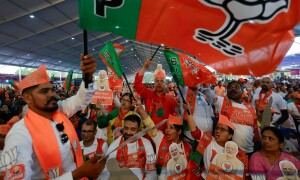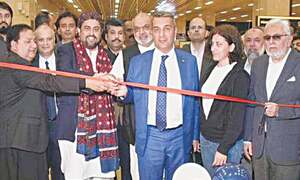Draupadi Basnet is a smallholder farmer in her 40s from the village of Agyuali in Nepal's terai (plains) land. She used to grow rice and only rice on the 1.5 hectares of land belonging to her in-laws. Like 75 per cent of the working population engaged in rice farming, that's all she knew, until 2012.
With no irrigation canal near her village, she says, she would just sit back after the sowing and wait for the rains. In a good year she earned as much as 15,000 Nepali rupees (PKR 15,834).
That year, Draupadi turned her paddy into a banana plantation.
"Climate induced her to change," says Atiq Rahman, executive director of Bangladesh Centre for Advanced Studies. Hers, he says, is a perfect example of how communities are making adaptations to climate.
In the last several years, Basnet had begun to notice a shift in the monsoon season. The rains she would wait for endlessly would never come at the right time and she began to feel the impact of climate change.
"The rains became more and more erratic and the growing season kept shortening."
 |
| A rice field in Nepal. -Photo by Zofeen T Ebrahim. |
On the sidelines of the 8th Annual Community-based Adaptation (CBA) Conference in Khatmandu, Rahman told Dawn.com:
"Extreme events will occur more frequently and more intensely by climate change though they may not necessarily be caused by it. But unfortunately, it is the poor who will bear the brunt of it."
Also participating in the conference organised by the International Institute for Environment and Development was Sam Bickersteth, chief executive of Climate and Development Knowledge Network (CDKN). Bickersteth emphasised the power of CBA and how it "harnesses local capacity and resources, builds on indigenous knowledge and recognises the potential of autonomous adaptation."
Rice is, by far, the most important staple crop of Nepal and is grown in 1.53 million hectares and the productivity is 2.56 t/ha on about 50 per cent of the total agricultural area. It contributes to nearly 20 per cent to the agricultural gross domestic product, accounting for 50 per cent of the total calorie requirement of the Nepalese people.
However, with Nepal in the throes of climate aberrations, and the farmers clinging on to ancient farming practices, it is becoming increasingly difficult to be productive.
 |
| A rice field in Nepal. -Photo by Zofeen T Ebrahim. |
Basnet's case is not too different from those of smallholder farmers in Pakistan, who also talk of fluctuating temperatures and unpredictable precipitation. Perhaps, then, some lessons can be learnt from Nepal.
Pakistani economist and water expert Dr Pervaiz Amir says that while the best quality rice that is grown in Pakistan is dependent on rains and supplemented by irrigation, it would be prudent to use "water which is scarce for high value fruits and vegetables for export".
Both geographically and topographically, the tarai in Nepal can be likened to some areas below the motorway, like Lillah, parts of Mianwali, and the delta region in Sindh.
Although not too enthusiastic about the idea of growing bananas (which can be grown in the delta area), Dr Amir says: "We can look at alternatives like citrus, vegetables and fish".
And where there is no irrigation, he suggests taking up dry-land farming growing pomegranate, almonds, investing in honey production and rearing livestock and ostrich, (which has a very high value for export). He also places a lot of emphasis on growing trees for fuelwood and fodder. "More trees will bring more rain!"
Additionally, Dr Amir says, "Maize should come in fast as it has numerous by-products. You see, it is the market that determines what will be produced in an economical way. Complex crops require a lot of institutional support with the latter creating or generating high value from exports."
Meanwhile, Rahman says: "What needs to be done is use indigenous knowledge, add scientific knowledge to it and then transfer it back to the communities." If that does not happen, "the knowledge gap will consequently threaten productivity."
But it's easier said than done.
Prabha Pokhrel, who has been working with the smallholder farmer community for years as a social development expert and chairperson of the Integrated Development Society in Nepal, knows that too well.
"It's very difficult to change the mindset here. People are very reluctant to change crops. We've tried to encourage them to change from rice to water melon and peanuts which uses less water and can be 10 times more profitable but it took a very rigorous effort to bring about the changeover."
Even for Basnet, the decision to change her decades old practice of cultivating rice to something totally alien to her was not an easy one. But after seeing how much she profited, four farmers decide to follow her and took to cultivating bananas.
Saraswati Bhurtyal, a project officer with the non-governmental organisation LI-BIRD (Local Initiatives for Biodiversity Research and Development) in Nepal, has known Basnet since 2007. Back then, her organisation first began work in Agyauli and provided Basnet with technical assistance, as well as the sucker (shoot) through which the fruit is propagated.
"After she converted her land into a banana plantation, we've all noticed the change in her and her household. She is happier, more confident and her family is eating well. Her two younger children are continuing with education instead of dropping out as many do, and her eldest, a son, who had gone as a migrant worker, to some Gulf country, has returned and wants to help his mother in farming. He realises there is more money in this."
Bhurtyal says her son will cultivate another 1.5 ha of their land that remained uncultivated, as she didn't want to take the risk given the unpredictable weather condition. "It's easier to grow bananas than rice," she says.
She has also experimented with intercropping and grows pumpkin, radishes and carrots. "Now, she earns NPR 40,000 (PKR 42,226) from the bananas and about Rs 30,000 (PKR 31,669) from intercropping," says Bhurtyal.
Unlike banana, rice (a water-intensive crop needs three or four waterings in a season that lasts two-and-a-half months and) there is a long wait before farmers can reap the benefit.
On the other hand, with bananas, the time between planting and harvesting is shorter and she gets a regular amount of money by selling bunches every other week.













































